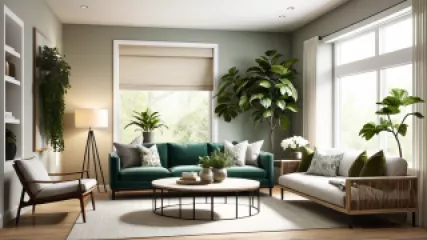Ultimate Guide to the Psychology of Space Design and Its Impact
The Ultimate Guide to the Psychology of Space Design and Its Impact
The spaces we inhabit have a profound impact on our mental well-being, shaping our emotions, productivity, and overall quality of life. From the cozy confines of our homes to the bustling open-plan offices, the design of our environments can either nurture or hinder our psychological needs. In this comprehensive guide, we'll delve into the fascinating world of space psychology and explore how intentional design can positively influence our mental health and emotional state.
Unlocking the Power of Space Design
The relationship between our physical surroundings and our mental state is a complex and often overlooked aspect of human experience. Yet, the psychological effects of space are undeniable, with numerous studies highlighting the profound impact that our environments can have on our emotional well-being, cognitive abilities, and overall sense of contentment.
Whether we realize it or not, the spaces we inhabit shape our thoughts, feelings, and behaviors in subtle yet significant ways. From the calming influence of a well-designed living room to the productivity-boosting effects of a thoughtfully curated workspace, the psychology of space design plays a vital role in shaping our daily lives.
Exploring the Fundamentals of Space Psychology
At the heart of space psychology lies the understanding that our physical environment is not merely a backdrop to our lives, but an active participant in shaping our inner world. By delving into the principles of environmental psychology, we can uncover the hidden mechanisms that govern the relationship between space and mental health.
One of the key concepts in space psychology is the idea of environmental stimuli – the various sensory inputs, such as lighting, color, texture, and layout, that our brains process and interpret. These environmental cues have a profound influence on our emotional state, cognitive functioning, and overall well-being.
For instance, studies have shown that exposure to natural elements, such as plants or natural lighting, can have a calming and restorative effect on individuals, reducing stress levels and promoting feelings of tranquility. Conversely, cluttered or overly stimulating environments can contribute to feelings of anxiety, distraction, and even physical discomfort.
The Impact of Space Design on Emotional Well-being
Our emotional well-being is inextricably linked to the spaces we inhabit, as they can either nurture or hinder our psychological needs. By understanding the emotional impact of space design, we can create environments that foster positive mental health and support our overall sense of well-being.
One crucial aspect of space psychology is the concept of personal space – the invisible boundaries that individuals maintain around themselves, which can vary based on cultural, social, and personal factors. Respecting and accommodating these personal space needs can have a significant influence on an individual's sense of comfort, security, and belonging within a given environment.
Additionally, the sensory qualities of a space, such as its lighting, color scheme, and acoustic properties, can profoundly impact our emotional state. Warm, inviting lighting, for example, can foster a sense of coziness and relaxation, while harsh, fluorescent lighting may contribute to feelings of stress and fatigue.
Designing for Productivity and Cognitive Performance
Beyond the emotional realm, the psychology of space design also plays a crucial role in shaping our cognitive abilities and overall productivity. By understanding the psychological effects of space on our thinking and focus, we can create environments that enhance our concentration, creativity, and problem-solving skills.
One of the key factors in this regard is the concept of cognitive load – the mental effort required to process and respond to the stimuli in our environment. Environments that are overly cluttered, visually complex, or lacking in visual hierarchy can contribute to a higher cognitive load, leading to feelings of mental fatigue, distraction, and decreased productivity.
On the other hand, spaces that are designed with clear, intuitive layouts, strategic use of color and lighting, and purposeful zoning can help reduce cognitive load and foster a sense of focus and concentration. By optimizing the design of our workspaces, we can create environments that empower us to perform at our best and unlock our full potential.
Designing for Mental Health Support
In recent years, there has been a growing recognition of the role that space design can play in supporting mental health and well-being. By creating environments that cater to the psychological needs of individuals, we can foster a sense of safety, comfort, and emotional support – crucial elements in promoting overall mental health and resilience.
One innovative approach to this is the concept of therapeutic design, which aims to intentionally integrate mental health considerations into the design of various spaces, from healthcare facilities to educational institutions and community centers. These spaces are designed to reduce stress, promote relaxation, and provide a sense of refuge and emotional support for individuals struggling with mental health challenges.
Through the strategic use of natural elements, calming color palettes, and soothing sensory experiences, therapeutic design can create environments that enhance the psychological well-being of those who inhabit them. By prioritizing mental health in the design process, we can work towards creating a more inclusive and supportive built environment for all.
Empowering Mental Health Through Online Spaces
In the digital age, the psychology of space design extends beyond the physical realm, as our virtual environments also play a significant role in shaping our mental health and well-being. From the way we design our personal digital workspaces to the overall user experience of online platforms, the psychology of space design has a profound impact on our emotional state and cognitive performance in the digital sphere.
One key aspect of this is the concept of digital minimalism – the practice of intentionally curating and streamlining our digital environments to reduce cognitive load and promote focus and mindfulness. By eliminating digital clutter, optimizing interface design, and creating distraction-free spaces within our online experiences, we can foster a sense of calm, control, and mental clarity that can have a positive ripple effect on our overall well-being.
Additionally, the rise of virtual mental health support platforms has highlighted the importance of designing online spaces that are not only visually appealing but also emotionally supportive and psychologically safe. These platforms prioritize user experience, incorporating design elements that foster a sense of trust, empathy, and emotional connection – essential components in creating an environment where individuals feel comfortable seeking and receiving mental health support.
Incorporating Space Psychology into Design Practices
As we have explored, the psychology of space design is a multifaceted and complex field, with far-reaching implications for our mental health, cognitive performance, and overall quality of life. By integrating these principles into our design practices, we can create environments that not only look visually appealing but also actively support and nurture our psychological needs.
One key aspect of this is the need for a holistic, user-centered approach to space design, where the focus is on understanding the specific needs, preferences, and behavioral patterns of the individuals who will be inhabiting the space. This may involve conducting user research, gathering feedback, and continuously iterating on the design to ensure that it aligns with the psychological needs of the target audience.
Additionally, interdisciplinary collaboration between design professionals, psychologists, and other relevant experts can provide a more comprehensive and informed perspective on the psychology of space design. By bringing together diverse areas of expertise, we can develop innovative solutions that seamlessly integrate mental health support and cognitive optimization into the design of our built and digital environments.
Conclusion: Embracing the Psychology of Space Design
In the ever-evolving landscape of our built and digital environments, the psychology of space design has emerged as a critical area of focus, with far-reaching implications for our mental health, emotional well-being, and overall quality of life. By embracing the principles of space psychology and incorporating them into our design practices, we can create spaces that not only look aesthetically pleasing but also actively support and nurture our psychological needs.
From the cozy confines of our homes to the bustling open-plan offices, the intentional design of our environments can have a profound impact on our emotional state, cognitive performance, and overall sense of well-being. By understanding the psychological effects of space and leveraging this knowledge to create environments that cater to our mental health needs, we can unlock the transformative power of space design and pave the way for a more mentally resilient and fulfilling future.
As we continue to navigate the complex and ever-changing landscape of our built and digital worlds, the principles of space psychology will only become more crucial in shaping our collective well-being. By embracing this powerful field of study and putting it into practice, we can design environments that not only look stunning but also nurture our emotional, cognitive, and psychological needs – a true testament to the transformative power of space design.






